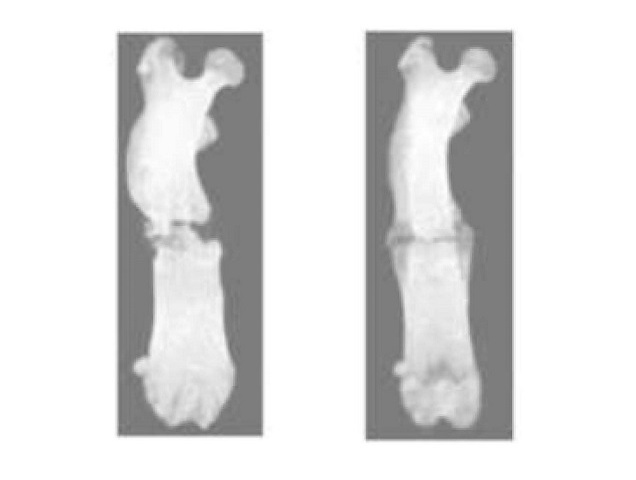Research News
Apr 17, 2024
- Medicine
New treatment method using plasma irradiation promotes faster bone healing
Displaced fractures also exhibit stronger unions than nonirradiated ones
Effect of plasma irradiation on broken bone
An X-ray image of a control rat femur that has not properly healed compared to a rat femur in its eighth week of plasma irradiation.
Credit: Osaka Metropolitan University

“Break a leg!” is a welcome blessing of good luck, but who wants to hear that they have actually broken a bone? What’s worse, fractures that are displaced or complex require surgery and possibly lengthy recovery times while the patient remains partly or wholly immobilized.
Aiming to shorten recovery times, an Osaka Metropolitan University-led research group is focusing on plasma irradiation as a treatment method to speed up bone healing.
The Department of Orthopedic Surgery’s Kosuke Saito, a graduate student in the Graduate School of Medicine, Associate Professor Hiromitsu Toyoda, and Professor Hiroaki Nakamura, and Graduate School of Engineering Professor Jun-Seok Oh were among the researchers who used laboratory rats for their experiment.
The researchers broke the legs of the rats in two ways. One group of 24 rats had normal fractures that are generally easy to heal. The other group of 20 rats had fractures known as nonunion ones where healing is usually prolonged or does not happen. Some were then irradiated with non-thermal atmospheric-pressure plasma, which didn’t offer the normal fracture group any significant advantages but boosted the healing and recovery time of the rats with nonunion fractures. The strength of the healed areas of the irradiated nonunion rats was also about 3.5 times stronger than that of the nonirradiated ones.
Furthermore, in vitro study of pre-osteoblastic cells irradiated with the plasma for 5 to 15 seconds showed that the activity of a protein that is an indicator of osteoblast differentiation increased, indicating that maturation of these bone-forming cells was progressing.
“Collaboration between the medical and engineering fields creates new medical technologies that have never before existed,” Professor Toyoda declared. “In the future, combining this treatment method with current fracture treatments is expected to contribute to more reliable bone fusion and shorter recovery times.”
The results were published in PLOS ONE.
Funding
This work was supported by JSPS Kakenhi grant number JP19K03811 and the Glocal hub of wisdom and wellness filled with smiles.
Paper information
Journal: PLOS ONE
Title: Fracture healing on non-union fracture model promoted by non-thermal atmospheric-pressure plasma
DOI: 10.1371/journal.pone.0298086
Authors: Kosuke Saito, Hiromitsu Toyoda, Mitsuhiro Okada, Jun-Seok Oh, Katsumasa Nakazawa, Yoshitaka Ban, Kumi Orita, Akiyoshi Shimatani, Hana Yao, Tatsuru Shirafuji, Hiroaki Nakamura
Published: April 16, 2024
URL: https://doi.org/10.1371/journal.pone.0298086
Contact
Graduate School of Medicine
Email: h-toyoda [at]gmail.com
*Please change [at] to @.
SDGs
